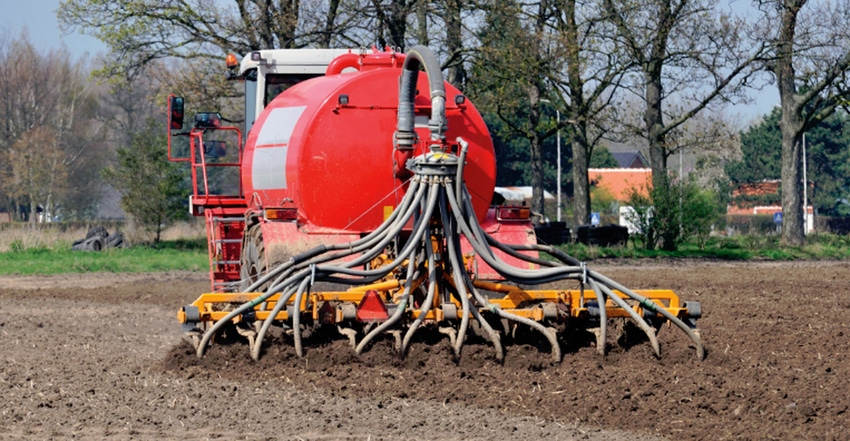March 2, 2018

As temperatures start to climb and the snow melts, farmers are looking ahead to spring fieldwork. If applying manure is in your plans, stop and consider the following four factors before getting out in the fields this spring.
These recommendations come from Jim Friedericks, outreach and education adviser for AgSource Laboratories, a soil testing and crop advisory service based at Ellsworth in central Iowa:
1. Spring weather raises risks. “While most growers apply manure postharvest in the fall, there are good opportunities to apply in the spring as well,” Friedericks says. “But with wet soil and cool spring weather, there can be a greater risk of soil compaction, nutrient runoff and stream contamination.”
Applying manure earlier, to frozen ground, might be easier, but it poses the greatest risk of nutrient loss and runoff. Rather than rushing to spread manure just to get rid of waste, manage it as a nutrient-rich resource that will benefit crops and cropland. Waiting and applying when field conditions improve is easier said than done, but it is a worthy goal, especially with increased input costs and environmental concerns.
2. Manure nutrients are volatile. Manure is rich in nitrogen, potassium, phosphorus and sulfur. In solid and dry manure, these nutrients are fairly stable, being associated with the solid particles. In liquid manure, the solid particles contain most of the phosphorus and some of the organic nitrogen and sulfur. But potassium and most of the nitrogen, as ammonium, is in the liquid portion. Ammonium is a measure of the amount of immediately available N.
Testing the ammonium levels can help determine how to best apply and treat manure. For example, manure from a swine pit with high ammonium levels should be injected into the soil to prevent volatilization. But when soil temperatures are at or above 50 degrees F (at 4-inch depth) the ammonium is subject to the nitrification process and the potential for leaching as nitrate. Manure with low ammonium content can be broadcast with fewer risks, but in general, manure should be incorporated into the soil quickly to reduce nitrogen losses and avoid surface runoff.
3. Book value vs. actual manure nutrient content. Although there are “general book values” on the nutrient content of manure, there are many influencing factors, including animal species, rations, production management and facility type. Even the bedding type makes a difference. The type of manure storage and handling or even the pit agitation system can all move numbers as well.
“If you don’t test, you won’t know the value of the nutrients you’re applying,” Friedericks says.
Manage manure as a crop nutrient resource. The minimum recommendation suggests testing for total N, P, and K along with moisture. Friedericks says testing for ammonium (NH4) can be very useful as well. Manure application rates should be based on soil testing and the fertilization requirements of your next crop. Typically, on farms with a manure management plan, there will be an N or P limit that must be followed.
4. Take time to sample and ship carefully. Ensuring a quality test result always starts with a properly collected, representative sample. Sampling guides are available from testing laboratories or university Extension offices. But if manure samples aren’t shipped properly, they can actually explode when received at the lab.
“I’ve seen it happen and it’s awful,” Friedericks says. “We sent the lab tech involved home for the rest of the day.” Here are a few reminders:
• Use the proper container. Do not use old Gatorade or shampoo bottles. Call the lab to order your plastic sample jars. Glass containers will not be accepted.
• Label samples immediately. Full sample jars look very similar. Be sure to label and record sample numbers on the container and on the submission form. When shipping the samples, seal the sample jar in a plastic bag, but place the submission form outside the bag. This will help keep the paperwork clean in case of a leak.
• Handle samples carefully. Remember, manure is a biologically active material. It is best to collect the samples, begin to cool or freeze them immediately, and send them to the laboratory the same day if possible, or store them frozen. Do not let manure samples sit in hot areas, such as a dashboard of a truck, for any period of time.
Source: AgSource Laboratories
You May Also Like




